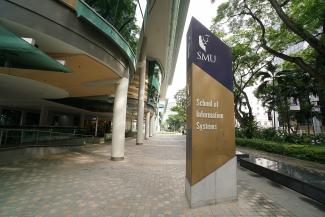
SINGAPORE, 6 April 2020 (Monday) - COVID-19 has spread far and wide because it is highly contagious and also because it can start spreading before symptoms appear. Confirmation regarding this type of spread has emerged over the last days but a group of researchers at the National University of Singapore (NUS) and the Singapore Management University (SMU) foresaw this three weeks ago and teamed up to create a tool that enables administrators to estimate people counts in different buildings on campuses.
The tool enables decision makers to identify places on campus where people concentrations are high. Like an eye in the sky, it allows leaders to make principled choices about what actions to take to reduce the likelihood of person to person COVID-19 transmission. It also can inform about the effectiveness of policies. For example, when lecture halls effectively shut as a result of the implementation of e-learning, are students amassing at some other location?
“The beauty of this system lies in its ability to accumulate useful information and to share it without further disrupting life on campus,” said Professor Michael Chee from NUS, who led the initiative.
“By using Wi-Fi signal strength received from thousands of mobile devices across campus, location information can be aggregated and mapped over time to inform about where and when people aggregate,” added Associate Professor Rajesh Balan from SMU who provided the key techniques to map devices to locations.
The system which went live on 3 April 2020 was set up in record time as a result of close collaboration between the university-based design team and its support persons, IT professionals, NUS leadership and private companies including Aviation Virtual and ESRI who provided mapping support.
“During SARS, I felt powerless to help but over the 17 years since then, Singapore’s scientific base has grown so much, I was determined to put these intellectual assets to work. It is one thing to have an idea, but to move it into something real instead of just being anxious or negative, is something very important at this time,” Prof Chee said. “Most of the interdisciplinary team have different backgrounds. Apart from myself and Assistant Professor Thomas Yeo, a world leader in brain mapping and an academic staff at NUS, almost every other contact we made was a cold call made from recommendations collected from anyone who offered tips.”
Strangers from different backgrounds came together, worked collaboratively using social media and remote conferencing tools to collectively build something that may be of benefit to society.
The next step in the Spacer project is to work with the Nanyang Technological University to put up the same system and concurrently plan to upscale the effort to the whole of Singapore. For this, a different method of data collection will be necessary. Think of the latter effort as Google Maps or Waze for planning a trip, but for managing human rather than vehicular traffic. We use Google Maps or Waze every day to help us avoid crowded roads. Everyone contributes some anonymized personal information to benefit the whole community. Co-operation of telecom operators to obtain cellular data like in Germany, Italy and Austria, is presently being sought.
Locking down the whole country is what has been practiced in several countries. However, this cannot be sustained for long periods without significant damage to the economy and to collective psyches. By having intelligent management of people concentrations and flows, the Spacer project seeks to provide a calibrated solution for limiting disease spread that complements efforts made by another home-grown technological initiative ‘Trace Together’ which focuses on contact tracing.
Statistical modelling shows that a combination of measures is necessary to clamp down the spread of COVID-19. Associate Professor Alex Cook, statistical epidemiologist from NUS who published the modelling study in a major scientific journal on 23 March 2020, reinforced the point that, “there is room for multiple approaches”.
What is important, the team agrees, is that we work together, stay engaged and support one another’s efforts to contain this global menace.
Please refer to the Annex and https://bit.ly/2ULHmzD for more information about the Singapore Spacer.